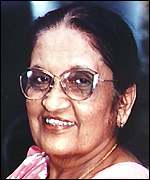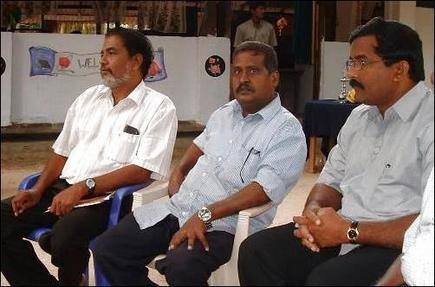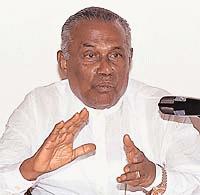|
Pirapaharan |
|||
|
By: T. Sabaratnam 9. TNT matures into the LTTE The need for a Veeran The Duraiappah murder delivered the message Pirapaharan wanted to convey: a new force prepared to hit back had entered the Tamil scene. That created a tremendous impact among the Tamils and the Sinhalese. Among the Tamils, the need for a Subash Chandra Bose had been felt for some time. Thanthai Chelva, adored as Eelathu Gandhi, who provided the father-figure Tamils required, had failed. His path of non-violent struggle had failed to win for the Tamils their freedoms and rights and had brought among them a sense of insecurity. Their resistance was suppressed by the use of Sinhala mob and state violence. The moral force of non-violence had been spurned. Tamils needed a stronger, fiercer force that could hit back, a Strongman or a Veeran [warrior hero]. Duraiappah's murder provided the Tamil people that stronger force, a group of boys willing to hit back at the risk of their lives. The manner in which Tamil people reacted to the Duraiappah murder showed their feeling clearly. They were sad that a people-friendly mayor was killed. They were, at the same time, happy that a traitor who helped Sirimavo Bandaranaike - who enacted a constitution that enslaved the Tamil people - was killed. Their hatred of Sirimavo Bandaranaike, whom they considered the Queen of Sinhala extremism, was so intense they were prepared to sacrifice a popular politician. The immediate reaction of the conservative Jaffna man to the Duraiappah slaying was one of adoration. 'Boys have done it. Our boys have taught the necessary lesson. We have a new force that can hit back.' They were proud of what the boys had done. Weakening the Brake The Sinhala reaction was one of anger. They attacked the moderate Tamil leadership and accused them of being the "brains behind the boys." Intelligence reports sent by the Tamil United Front (TUF) desk of the Criminal Investigation Department (CID) blamed the TUF, particularly Amirthalingam, for the violence. One report read: "Amirthalingam is the brain behind all the violent groups. Leaders of all groups meet him regularly." The report was not completely false. During the Tamil Youth Forum (TYF) days Pirapaharan, Thangathurai, Kuttimani, Sri Sabaratnam, Satyaseelan, Muthukumaraswamy and Varatharajah Perumal used to meet Amirthalingam regularly. They exhibited special affection for Amirthalingam. Thanthai Chelva deputed Amirthalingam to be in touch with the revolting youths. He used Amirthalingam as a break. Sinhala journalists and politicians, some of them rabid communalists, failed to realize that. They attacked Amirthalingam and weakened the hold he had on the violent youth. The Duraiappah murder was a profound shock for Sirimavo Bandaranaike.
Sirimavo Bandaranaike She ordered a police crack-down on Tamil militants. Police was told to arrest the murderers before Duraiappah’s funeral. Police swept all the known members of the TYF into jail. With a week, July 28 to August 4, they arrested: K Sivanandan, A Mahendra, Namasivayam Anandavinayagam, Somasundaram Senathirajah, M Sinniah Kuventhirarajah, A Mylvaganam Rajakulasuriar, Ananda Poopathy Balavadivetkaran, Sivaramalingam Chandrakumar, Sivaramalingam Suriakumar, Thambithurai Muthukuarasamy, Aseervatham Thasan, K Sundarampellai Sabaratnam, Annamalai Varathararajah, S Appathurai Nithianandan, Sithamparam Pushparajah, Ramalingam Calendaran, Ponnuthurai Satkunaligam, Kurululesingam, T Jeevarajah, M Balaratnam, P Veeravagu, K Utharsen, K Sivajeyam, Thambipillai Santhathiar, Amithalingam Anandakumar, Vaithulingam Sritharan and some others. None of them knew about the murder. None of them was aware of the existence of the Tamil New Tigers (TNT). However, the Sinhala-controlled media boasted that the murders had been caught. Those connected with the murder were arrested during late August and September. That was during the search for lower-ranked members of the TYF. These were some who were taken in: V Sathasivam Sathanandasivan, Somu Kulasingam, Selvaratnam Selvakumar, Ratnapala, Joga Chandran, Rajendram Jeyarajah, Visvajothy Ratnam, P Kalapathy, S Loganathan, Arumugam Kirubakaran, Ranjan, Varithamby Sivarajah, Muthuthamby Vasanthakumar, Mary Alphorns. Of these, Arumugam Kirubakaran was arrested on 21 August 1975 and Kalapathy was arrested on 19 September 1975. They spilled the beans. It was through them that the existence of the TNT and its leader came to be known. Kirubakaran and Kalapathy fell into the hands of the police as they had ignored Pirapaharan’s instructions: not to sleep in their homes and to be constantly armed. They were caught when police raided their homes. They did not have any weapon with them. Their explanation for this failure was that they had no arms to carry. There were only two revolvers with the TNT at that time and they were taken by Pirapaharan and Patkunarajah. Pirapaharan carried with him the rusty revolver he used to shoot Duraiappah. Pirapaharan had taught them the use of kitchen knives and chillie powder for self-defence. He had told them to carry at least a kitchen knife with them. Pirapaharan and his colleagues drove away in Duraiappah’s car after the murder to Neerveli, abandoned the car there and walked in different directions. Pirapaharan walked to the house of a trusted contact and told him he wanted to sleep in his home. His contact was not aware of the Duraiappah shooting. Pirapaharan did not drop even a hint about the murder. He took the revolver out, placed it under his pillow and dozed off. When the contact woke up in the morning, Pirapaharan was gone. A little later the village was talking about the assassination, the first political murder in recent Tamil history, an event that also altered the course of Sri Lankan history. It is Pirapaharan’s habit not to talk about his plans or actions. He refrains from even dropping hints. He is also careful about his security. After the murder, he avoided the hideouts known to his three accomplices. He did not want to take the risk of being caught through the information drawn out of his three colleagues if they were caught. Pirapaharan was advised by his friends to flee to Tamil Nadu. He declined. He told his friends that was not the time to run away. He should be in Jaffna to capitalize on the impact the Duraiappah murder had created. Jaffna youths had heard Pirapaharan’s name before. Now, the halo of Duraiappah's murder had made him a hero. His group, the TNT, had earned a name for itelf. Some youths wanted to join him. One such youth was S. Subramaniam. Known as 'Baby,' he was operating on his own.
(L-R) V.Balakumaran, Baby Subramaniam and Mr.Thangan (TamilNet, 2003) The Duraiappah murder had converted him into a Pirapaharan fan. He still is. He is his Education Porupalar (minister) in the Vanni administration. While Pirapaharan was consolidating himself in Jaffna,
Jayewardene was building himself in the south. He resigned his Colombo
South parliamentary seat on 22 May 1975, the third anniversary of the
Republican constitution. The issue was the term of office of the
National State Assembly. The 1972 constitution laid the term as five
years from the date the constitution came into operation. Jayewardene
challenged it. He said people elected the Sirimavo Bandaranaike
government for a period of five years at the 1970 election. He resigned
his seat at the end of five years and challenged the government to test
public opinion.
Thondamon While Pirapaharan and Jayewardene were consolidating their positions, the Sirimavo Bandaranaike government was writhing with internal bickering. Felix R. Dias Bandaranaike, who opposed the LSSP- CP nationalization program, manipulated the ouster of the LSSP from the government, which subsequently led to the withdrawal of the Communist Party from the government. Bank Robberies The sacked LSSP reacted with anger and vengeance. It moved a vote of no-confidence against the prime minister, charging her with misuse of power for personal financial benefit. LSSP leaders alleged that the prime minister had sold a portion of her coconut estate during the period the Land Reform Law was enacted, beating the very purpose of the law. The motion, though defeated, damaged her reputation. The LSSP supported another no-confidence motion against Justice Minister Felix R. Dias Bandaranaike, accusing him of misuse of power to harass opposition opponents. While this destructive match was consuming the time of the Sinhala leader,s Pirapaharan quietly went to Vanni, which he built later into his stronghold, and set up his training camps in Vavuniya. Pirapaharan, who had roamed widely the wild woods of Vanni during his boyhood where his father Velupillai was a land officer, knew that territory of thick forest would be his fall back when the armed might of the state struck back. Pirapaharan established his first training camp in an out-of-the-way place two miles (three kilometers) from Vavuniya town. He named it 'Poonthoddam' meaning Flower Garden. It was a 40- acre farm with well- laid flower gardens, vegetable plots, paddy fields and thick jungle in the rear. In the bosom of the jungle, he built huts where militants were taught martial arts and were given shooting practice. New recruits taken to Poonthodam were made to work in the vegetable plots and in the paddy fields which provided the ice and vegetables the camp required. The cadres received military training in the mornings and evenings. Pirapaharan was very particular that they learn to shoot accurately. Cutouts of men and marked spots on trees served as targets. Pirapaharan visited the shooting grounds very often and supervised the training. One of his former trainers, now with EROS, described to me one of Pirapaharan’s revolver shooting demonstrations. "He walked up slowly; revolver tucked into his waist belt, took a sudden u-turn, whipped out the revolver in a flash and fired at the red spot marked on the tree. He smiled with satisfaction as the bullet hit the target," he said. He added that Pirapaharan was a hard taskmaster. "He gets angry if you miss the target. 'If you miss your shot the enemy will shoot you,' he shouts," he said. Pirapaharan needed money to run the training camp. He initiated an internal discussion about ways of raising money. They could not do it openly because police was constantly on the lookout for them and the people were scared to fund them. They decided to follow the JVP example and rob banks. 'Was it not immoral' was the main objection raised by some in the central committee. Banks deal with people’s money. Can a militant movement fighting for the rights of the people rob people’s money? Pirapaharan, it is said, suggested the way out of this dilemma. "Let’s rob a state bank," he said. The additional reason he gave to support his suggestion to rob a state bank was: The Sri Lankan government, which collected taxes from all the people, neglected the Tamil areas in national development schemes. Therefore, it is not immoral to rob the government to finance the Tamil liberation struggle. Pirapaharan then planned the robbery meticulously. He detailed some cadres to plan the robbery. He discussed with that group all aspects of the plan. They were asked to watch the time of the opening of the bank, when business started, the rush and lean times, where cash and jewelry were kept, the number of men who should take part in the operation, the mode of travel to the bank and the get-away. Every detail was observed, discussed and incorporated into the plan and practiced. On 5 March 1976, Pirapaharan led a selected group into the People's Bank branch at Puttur after it commenced business, waved the pistols and ordered all employees to gather in the manager’s cubicle. The awe-struck employees obeyed. They were ordered to stand with their hands raised. Two groups went to the cashier and the strong room. They gathered the cash and jewelry in two separate gunny bags and left saying: Sorry for the inconvenience. They carried away Rs.500,000 in notes and Rs. 200,000 worth of jewels. Jaffna’s first robbery was over in just five minutes. The bank robbery shook the government and the police and the government ordered the wiping out of the TNT. The police headquarters in Colombo set up a special intelligence squad in Jaffna to deal with armed groups. The intelligence experts, who hitherto recorded the speeches of Tamil politicians and their activities, were told to collect information about the militants. Inspectors Bastiampillai and Pathmanathan were two of the officers who handled that job. They started to build a network of informants. Enthused by TNT’s success in robbing the Puttur bank, the Eelam Liberation Organization (ELO) robbed the Rural Bank of the Puloly Multi-Purpose Cooperative Society. Unlike the People’s Bank, Rural Banks are not state banks, They provide credit for farmers. ELO, which talked about social reformation, robbed poor people’s money. The gang, led by Varatharaja Perumal, was arrested and the loot, cash and jewellery, recovered. Others arrested were Hens Mohan, Chandra Mohan, and Thanga Mahendran. The Bank manager, Velupillai Balakumar, was also arrested and charged with connivance. Inspector Pathmanathan made the arrests. ELO was decimated and the group automatically disappeared, the only instance in the history of Tamil militancy in which leaders deserted en masse their organization. The Founding of the LTTE Emboldened by the success of the Duraiappah murder and the Puttur bank robbery, Pirapaharan decided to put his long time dream of setting up an urban guerilla outfit into operation. He had prepared for it from the time he was in Tamil Nadu. He decided on a name. It should have the name ‘Tamil Eelam’, the land of his dream. It was not the Eelam Suntharalingam proposed in 1960. Eelam in Tamil literature denoted Sri Lanka, the entire country. Pirapaharan was not concerned about the entirety of the country. He was only concerned about the northern and eastern portion, the region that was historically under Tamil control, the Tamil homeland. The word ‘Tiger’ should be in the name, he decided. Tiger was the insignia of the ancient Tamil Chola kingdom. It was under the Cholas that Tamils reached the height of their civilization and power. Then the word ‘Liberation’ should also be in it. His movement is going to be a liberation struggle, a struggle to liberate the Tamils from Sinhala oppression. The name finally evolved was Liberation Tigers of Tamil Eelam, LTTE in brief. Pirapaharan had already prepared a logo. While in
Madurai he got an Indian artist to draw it. He told him his idea: the
head of a roaring Tiger, paws outstretched, with two rifles and .33
bullets set against a circle ringing the tiger’s head. When the artist
showed him the sketch Pirapaharan was thrilled. He had also prepared the draft of the constitution. The objectives he formulated were; · Total independence of Tamil Eelam. · The establishment of a sovereign, socialist democratic people's government. · Abolition of all forms of exploitation, the caste system in particular. · Establishment of a socialist mode of production. · Uphold armed revolutionary struggle; an extension of the political struggle for liberation. · Guerrilla warfare will be gradually and systematically transformed into a genuine people's war of liberation The organization was to be headed by a 5-member Central Committee. It was to have both a political and a military wing. It laid down a strict code of conduct for its members which included a ban on tobacco, alcohol, sex, family connections and joining other organizations or forming new ones after leaving the organization. The constitution was adopted by the new Central Committee elected on 5 May 1976, thus transforming the TNT into LTTE from that day. Pirapaharan was elected the political leader and military commander. The other members of the first central committee were: Nagarajah, Sellakili, Iyer and Vichchveswaran. Pirapaharan divided the military activities of the LTTE into three main divisions. They were; · Elimination of the police intelligence network and traitors, · Crippling the administrative structure Sri Lanka Government, and · Destroying army camps and bringing the areas under their control under the LTTE control and setting up administrative structures which would lay the foundation for the self-rule of Tamil Eelam. Pirapaharan foresaw a long-drawn out struggle and organized the LTTE as an urban guerilla movement, which he said was best suited to a numerically smaller community and the best method to mobilize the masses. In an interview he explained: Guerrilla warfare is really mass struggle. It is not in conflict with mass struggle. Guerrilla warfare is the highest form of mass struggle. When it takes root in the hearts of the entire populace and reflects their aspirations, it becomes a mass struggle. My object is to achieve this purpose of making all take -------------------------------------------------------------------------------------- Annex: The Struggle for Tamil Eelam and the Liberation Tigers
Chapter 10. The Mandate Affirmed
Earlier Chapters: Introduction Part 1 Introduction Part 2 Chapter 1: Why didn’t he hit back? Chapter 2: Going in for a revolver Chapter 3: The Unexpected Explosion Chapter 4: Tamil Mood Toughens Chapter 5: Tamil Youths Turn Assertive Chapter 6: Birth of Tamil New Tigers Chapter 7: The Cyanide Suicide Chapter 8: First Military Operation
|
|||
 Srimavo Bandaranaike
Srimavo Bandaranaike

 The
by-election was held on 18 July and Thondaman, one of the TUF
presidents, openly supported Jayewardene. The Federal Party and the
Tamil Congress, the other constituents of the TUF canvassed for
Jayewardene in secret. Jayewardene won by a majority of 25,801 votes.
The
by-election was held on 18 July and Thondaman, one of the TUF
presidents, openly supported Jayewardene. The Federal Party and the
Tamil Congress, the other constituents of the TUF canvassed for
Jayewardene in secret. Jayewardene won by a majority of 25,801 votes.